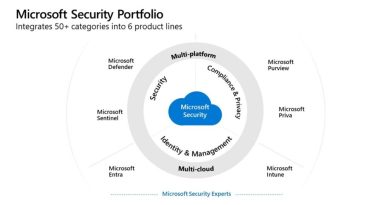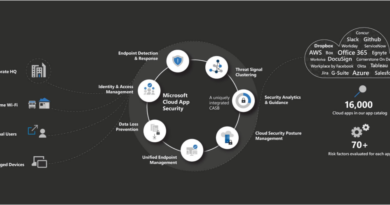DEV-0537 criminal actor targeting organizations for data exfiltration and destruction
In recent weeks, Microsoft Security teams have been actively tracking a large-scale social engineering and extortion campaign against multiple organizations with some seeing evidence of destructive elements. As this campaign has accelerated, our teams have been focused on detection, customer notifications, threat intelligence briefings, and sharing with our industry collaboration partners to understand the actor’s tactics and targets. Over time, we have improved our ability to track this actor and helped customers minimize the impact of active intrusions and in some cases worked with impacted organizations to stop attacks prior to data theft or destructive actions. Microsoft is committed to providing visibility into the malicious activity we’ve observed and sharing insights and knowledge of actor tactics that might be useful for other organizations to protect themselves. While our investigation into the most recent attacks is still in progress, we will continue to update this blog when we have more to share.
The activity we have observed has been attributed to a threat group that Microsoft tracks as DEV-0537, also known as LAPSUS$. DEV-0537 is known for using a pure extortion and destruction model without deploying ransomware payloads. DEV-0537 started targeting organizations in the United Kingdom and South America but expanded to global targets, including organizations in government, technology, telecom, media, retail, and healthcare sectors. DEV-0537 is also known to take over individual user accounts at cryptocurrency exchanges to drain cryptocurrency holdings.
Unlike most activity groups that stay under the radar, DEV-0537 doesn’t seem to cover its tracks. They go as far as announcing their attacks on social media or advertising their intent to buy credentials from employees of target organizations. DEV-0537 also uses several tactics that are less frequently used by other threat actors tracked by Microsoft. Their tactics include phone-based social engineering: SIM-swapping to facilitate account takeover, accessing personal email accounts of employees at target organizations, paying employees, suppliers, or business partners of target organizations for access to credentials and multifactor authentication (MFA) approval; and intruding in the ongoing crisis-communication calls of their targets.
The social engineering and identity-centric tactics leveraged by DEV-0537 require detection and response processes that are similar to insider risk programs – but also involve short response timeframes needed to deal with malicious external threats. In this blog, we compile the tactics, techniques, and procedures (TTPs) we’ve observed across multiple attacks and compromises. We also provide baseline risk mitigation strategies and recommendations to help organizations harden their organization’s security against this unique blend of tradecraft.
Analysis
The actors behind DEV-0537 focused their social engineering efforts to gather knowledge about their target’s business operations. Such information includes intimate knowledge about end-users, team structures, help desks, crisis response workflows, and supply chain relationships. Examples of these social engineering tactics include spamming a target user with multifactor authentication (MFA) prompts and calling the organization’s helpdesk to reset a target’s credentials.
Microsoft Threat Intelligence Center (MSTIC) assesses that the objective of DEV-0537 actors is to gain elevated access through stolen credentials that enable data theft and destructive attacks against a targeted organization, often resulting in extortion. Tactics and objectives indicate this is a cybercriminal actor motivated by theft and destruction.
While this actor’s TTPs and infrastructure are constantly changing and evolving, the following sections provide additional details on the very diverse set of TTPs we have observed that DEV-0537 is using.
Initial access
DEV-0537 uses a variety of methods that are typically focused on compromising user identities to gain initial access to an organization including:
- Deploying the malicious Redline password stealer to obtain passwords and session tokens
- Purchasing credentials and session tokens on criminal underground forums
- Paying employees at targeted organizations (or suppliers/business partners) for access to credentials and multi-factor authentication (MFA) approval
- Searching public code repositories for exposed credentials
Using the compromised credentials and/or session tokens, DEV-0537 accesses internet-facing systems and applications. These systems most commonly include virtual private network (VPN), remote desktop protocol (RDP), Virtual Desktop Infrastructure (VDI) including Citrix, or Identity providers (including Azure Active Directory, Okta). For organizations using MFA security, DEV-0537 used two main techniques to satisfy MFA requirements – session token replay and using stolen passwords to trigger simple-approval MFA prompts hoping that the legitimate user of the compromised account eventually consents to the prompts and grants the necessary approval.
In some cases, DEV-0537 first targeted and compromised an individual’s personal or private (non-work-related) accounts giving them access to then look for additional credentials that could be used to gain access to corporate systems. Given that employees typically use these personal accounts or numbers as their second-factor authentication or password recovery, the group would often use this access to reset passwords and complete account recovery actions.
Microsoft also found instances where the group successfully gained access to target organizations through recruited employees (or employees of their suppliers or business partners). DEV-0537 advertised that they wanted to buy credentials for their targets to entice employees or contractors to take part in its operation. For a fee, the willing accomplice must provide their credentials and approve the MFA prompt or have the user install AnyDesk or other remote management software on a corporate workstation allowing the actor to take control of an authenticated system. Such a tactic was just one of the ways DEV-0537 took advantage of the security access and business relationships their target organizations have with their service providers and supply chains.

In other observed activity, DEV-0537 actors performed a SIM-swapping attack to access a user’s phone number before signing into the corporate network. This method allows the actors to handle phone-based authentication prompts they need to gain access to a target.
Once standard user credentials or access was obtained, DEV-0537 typically connected a system to an organization’s VPN. In some cases, to meet conditional access requirements, DEV-0537 registered or joined the system to the organization’s Azure Active Directory (AAD).
Reconnaissance and privilege escalation
Once DEV-0537 obtained access to the target network using the compromised account, they used multiple tactics to discover additional credentials or intrusion points to extend their access including:
- Exploiting unpatched vulnerabilities on internally accessible servers including JIRA, Gitlab, and Confluence
- Searching code repositories and collaboration platforms for exposed credentials and secrets
They have been consistently observed to use AD Explorer, a publicly available tool, to enumerate all users and groups in the said network. This allows them to understand which accounts might have higher privileges. They then proceeded to search collaboration platforms like SharePoint or Confluence, issue-tracking solutions like JIRA, code repositories like GitLab and GitHub, and organization collaboration channels like Teams or Slack to discover further high-privilege account credentials to access other sensitive information.
DEV-0537 is also known to exploit vulnerabilities in Confluence, JIRA, and GitLab for privilege escalation. The group compromised the servers running these applications to get the credentials of a privileged account or run in the context of the said account and dump credentials from there. The group used DCSync attacks and Mimikatz to perform privilege escalation routines. Once domain administrator access or its equivalent has been obtained, the group used the built-in Ntdsutil utility to extract the AD database.
In some cases, DEV-0537 even called the organization’s helpdesk and attempted to convince the support personnel to reset a privileged account’s credentials. The group used the previously gathered information (for example, profile pictures) and had a native-English-sounding caller speak with the helpdesk personnel to enhance its social engineering lure. Observed actions have included DEV-0537 answering common recovery prompts such as “first street you lived on” or “mother’s maiden name” to convince helpdesk personnel of authenticity. Since many organizations outsource their helpdesk support, this tactic attempts to exploit those supply chain relationships, especially where organizations give their helpdesk personnel the ability to elevate privileges.
Exfiltration, destruction, and extortion
Based on our observation, DEV-0537 has dedicated infrastructure they operate in known virtual private server (VPS) providers and leverage NordVPN for its egress points. DEV-0537 is aware of detections such as impossible travel and thus picked VPN egress points that were geographically like their targets. DEV-537 then downloaded sensitive data from the targeted organization for future extortion or public release to the system joined to the organization’s VPN and/or AAD-joined system.
DEV-0537 has been observed leveraging access to cloud assets to create new virtual machines within the target’s cloud environment, which they use as actor-controlled infrastructure to perform further attacks across the target organization.
If they successfully gain privileged access to an organization’s cloud tenant (either AWS or Azure), DEV-0537 creates Global Admin accounts in the organization’s cloud instances, sets an Office 365 tenant level mail transport rule to send all mail in and out of the organization to the newly-created account, and then removes all other Global Admin accounts, so only the actor has sole control of the cloud resources, effectively locking the organization out of all access. After exfiltration, DEV-0537 often deletes the target’s systems and resources. We’ve observed deletion of resources both on-premises (for example, VMWare vSphere/ESX) and in the cloud to trigger the organization’s incident and crisis response process.
The actor has been observed then joining the organization’s crisis communication calls and internal discussion boards (Slack, Teams, conference calls…etc.) to understand the incident response workflow and their corresponding response. It is assessed this provides DEV-0537 insight into the victim’s state of mind, their knowledge of the intrusion, and a venue to initiate extortion demands. Notably, DEV-0537 has been observed joining incident response bridges within targeted organizations responding to destructive actions. In some cases, DEV-0537 has extorted victims to prevent the release of stolen data, and in others, no extortion attempt was made and DEV-0537 publicly leaked the data they stole.
Impact
Early observed attacks by DEV-0537 targeted crypto currency accounts resulting in compromise and theft of wallets and funds. As they expanded their attacks, the actors began targeting telecommunication, higher education, and government organizations in South America. More recent campaigns have expanded to include organizations globally spanning a variety of sectors. Based on observed activity, this group understands the interconnected nature of identities and trust relationships in modern technology ecosystems and targets telecommunications, technology, IT services and support companies – to leverage their access from one organization to access the partner or supplier organizations. They have also been observed targeting government entities, manufacturing, higher education, energy, retailers, and healthcare.
Microsoft will continue to monitor DEV-0537 activity and implement protections for our customers. The current detections and advanced detections in place across our security products are detailed in the following sections.
Actor actions targeting Microsoft
This week, the actor made public claims that they had gained access to Microsoft and exfiltrated portions of source code. No customer code or data was involved in the observed activities. Our investigation has found a single account had been compromised, granting limited access. Our cybersecurity response teams quickly engaged to remediate the compromised account and prevent further activity. Microsoft does not rely on the secrecy of code as a security measure and viewing source code does not lead to elevation of risk. The tactics DEV-0537 used in this intrusion reflect the tactics and techniques discussed in this blog. Our team was already investigating the compromised account based on threat intelligence when the actor publicly disclosed their intrusion. This public disclosure escalated our action allowing our team to intervene and interrupt the actor mid-operation, limiting broader impact.
Recommendations
Strengthen MFA implementation
Multifactor authentication (MFA) is one of the primary lines of defense against DEV-0537. While this group attempts to identify gaps in MFA, it remains a critical pillar in identity security for employees, vendors, and other personnel alike. See the following recommendations to implement MFA more securely:
Do:
Do not:
- Use weak MFA factors such as text messages (susceptible to SIM swapping), simple voice approvals, simple push (instead, use number matching), or “secondary email” based MFA methods.
- Include location-based exclusions. MFA exclusions allow an actor with only one factor for a set of identities to bypass the MFA requirements if they can fully compromise a single identity.
- Allow credential or MFA factor sharing between users.
Require Healthy and Trusted Endpoints
- Require trusted, compliant, and healthy devices for access to resources to prevent data theft.
- Turn on cloud-delivered protection in Microsoft Defender Antivirus to cover rapidly evolving attacker tools and techniques, block new and unknown malware variants, and enhance attack surface reduction rules and tamper protection.
Leverage modern authentication options for VPNs
VPN authentication should leverage modern authentication options such as OAuth or SAML connected to Azure AD to enable risk-based sign in detection. Modern authentication enables blocking authentication attempts based on sign in risk, requiring compliant devices for sign in, and tighter integration with your authentication stack to provide more accurate risk detections. Implementation of modern authentication and tight conditional access policies on VPN has been shown to be effective against DEV-0537’s access tactics.
Strengthen and monitor your cloud security posture
DEV-0537 leverages legitimate credentials to perform malicious actions against customers. Since these credentials are legitimate, some activity performed might seem consistent with standard user behavior. Use the following recommendations to improve your cloud security posture:
- Review your Conditional Access user and session risk configurations:
- Block High sign-in risk logins for all users
- Block Medium sign-in risk logins for privileged users
- Require MFA for medium sign-in risk logins for all other users
- Alerts should be configured to prompt a review on high-risk modification of tenant configuration, including but not limited to:
- Modification of Azure AD Roles and privileged users associated with those roles
- Creation/modification of Exchange Online transport rules
- Review risk detections in Azure AD Identity Protection
- Risk detections highlight risky users and risky sign-ins
- Administrators can review and confirm individual sign-ins listed here as compromised or safe

Improve awareness of social engineering attacks
Microsoft recommends raising and improving awareness of social engineering tactics to protect your organization. Educate members of your technical team to watch out for and report any unusual contacts with colleagues. IT help desks should be hypervigilant about suspicious users and ensure that they are tracked and reported immediately. We recommend reviewing help desk policies for password resets for highly privileged users and executives to take social engineering into consideration.
Embed a culture of security awareness in your organization by educating end-users about help desk verification practices. Encourage them to report suspicious or unusual contacts from the help desk. Education is the number one defense against social engineering attacks such as this one and it is important to make sure that all employees are aware of the risks and known tactics.
Establish operational security processes in response to DEV-0537 intrusions
DEV-0537 is known to monitor and intrude in incident response communications. As such, these communication channels should be closely monitored for unauthorized attendees and verification of attendees should be performed visually or audibly.
We advise organizations to follow very tight operational security practices when responding to an intrusion believed to be DEV-0537. Organizations should develop an out-of-band communication plan for incident responders that is usable for multiple days while an investigation occurs, documentation of this response plan should be closely held and not easily accessible.
Microsoft continues to track DEV-0537’s activities, tactics, malware, and tools. We will communicate any additional insights and recommendations as we investigate their actions against our customers.
READ MORE HERE



